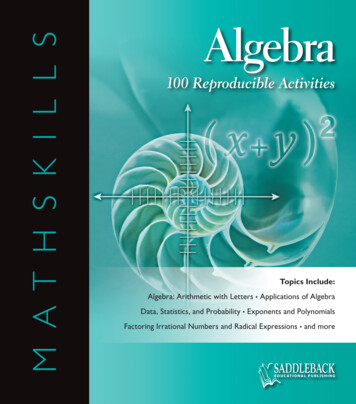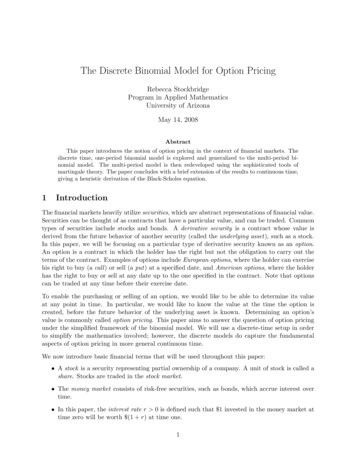
Transcription
NameDateSquaring a BinomialWhen you square a binomial, you can apply the FOIL method to find the product.You can also apply the following rules as a short cut.Rules for Squaring a Binomial1. Square the first term.2. Find 2 times the product of the two terms; use the sameoperation sign as the one between the two terms.3. Square the last term.ExampleSolve. (x 3)2Step 1 Square the first term.x is the first term(x x) x2Step 2 Find 2 times the product of the two2(x 3) 2(3x) 6xUse the plus sign.terms; use the same operation sign asthe one between the two terms.Step 3 Square the last term.32 9(x 3)2 x2 6x 9PracticeSolve.1. (5x 2)2Square the first term.5x is the first term(5x 5x) Find 2 times the product of the twoterms; use the same operation sign asthe one between the two terms.2(5x 2) 2(10x) Square the last term. 22 4Use thesign.(5x 2)2 2. (x 4)23. (x 8)24. (2x 6)25. (4x 4)26. (6x 12)2AlgebraSaddleback Educational Publishing 2006 (888) 735-2225 www.sdlback.com55
NameDateAdding PolynomialsWhen you add two polynomials, you do so by adding like terms. Terms are like termsif they have the same variable raised to the same power.Like TermsNot Like Terms2x2, 4x25x4, 4x5Rules for Adding Polynomials1. Write each polynomial in standard form.2. Line up like terms.3. Add the numbers in front of each variable. (Remember“1” is understood to be in front of a variable with no number).ExampleAdd. (4x2 2x 5) (3x4 3x 5x2)Step 1 Write each polynomial in standard form. (4x2 2x 5) (3x4 5x2 3x)4x2 2x 53x4 5x2 3xStep 2 Line up like terms.Step 3 Add the numbers in front of eachvariable.4x2 2x 5 3x4 5x2 3x3x4 9x2 1x 5PracticeAdd.1. (16x3 5 2x2) (5 3x3 x2)Write each polynomial in standard form.(16x3 2x2 5) Line up like terms.16x3 2x2 5Add the numbers in front of eachvariable.16x3 2x2 5 2. ( 2x3 5 3x) (2x3 2x 3x2)3. (15 4x2 x3) (5x3 10 x2)4. (5xy 3 2x2y) (14 5x2y xy)5. (7 5y3 3y4) (2y2 y4 12y3)Algebra56Saddleback Educational Publishing 2006 (888) 735-2225 www.sdlback.com
NameDateSubtracting PolynomialsWhen you subtract two polynomials, you do so by subtracting like terms. Terms are liketerms if they have the same variable raised to the same power.Like TermsNot Like Terms3x3, x35x, x5Rules for Subtracting Polynomials1. Write polynomials in standard form.2. Line up like terms.3. Change the sign of each term in the second polynomial.4. Add the numbers in front of each variable. (Remember,“1” is understood to be in front of a variable with no number).ExampleSubtract. (2x2 5x3 1) (5 5x2 3x3)Step 1 Write polynomials in standard form.Step 2 Line up like terms.Step 3 Change the sign of each term in thesecond polynomial.Step 4 Add the numbers in front of eachvariable(5x3 2x2 1) (3x3 5x2 5)5x3 2x2 1 (3x3 5x2 5)5x3 2x2 1 3x3 5x2 55x3 2x2 1 ( 3x3 5x2 5)2x3 3x2 4PracticeSubtract.1. (x 5 4x2) (10 3x2 – 5x)Write polynomials in standard form.Line up like terms.Change the sign of each term in thesecond polynomial.Add the numbers in front of eachvariable(4x2 x 5) –4x2 x 5 4x2 x 54x2 x 5 2. (x2 5 4x3) ( 10 2x2 5x3)3. ( 4 x3 3x2) (5x 5x2 14)4. ( 3x2 10 2x) (9 4x2 10x)5. ( 4x3 12 x) – ( 5x 10x2 3)AlgebraSaddleback Educational Publishing 2006 (888) 735-2225 www.sdlback.com57
NameDateMultiplying a PolynomialWhen you multiply a polynomial by a monomial, you multiply each term of thepolynomial by the monomial. When you multiply one term by another, you multiplythe numbers in front of each term. You also apply the rules for multiplying exponentsby adding exponents.(5x2)(2x3) 10x5(2x3)(3xy) 6x4yRules for Multiplying a Polynomial by a MonomialMultiply each term in the polynomial by the monomial:1. Multiply the numbers in front of the variables. (Remember that“1” is understood to be in front of a variable with no number)2. Add the exponents of variables of the same letter (Remember that“1” is understood to be the exponent of a variable with no exponent.)ExampleMultiply. 4x(2x2 x 6)Step 1 Multiply each term in the polynomialby the monomial.(4x)(2x2) 8x3(4x)(x) 4x2(4x)( 6) 24x8x3 4x2 24xPracticeMultiply.1. 3x3(4x2 2x 1)Multiply each term in the polynomialby the monomial.(3x3)(4x2) (3x3)(2x) (3x3)( 1) 2. 7x2( 3x3 2)3. –2x4 ( 4x2 x 3)4. x2(3x5 6x3 x)5. 5x4( 4x4 2x3 5)Algebra58Saddleback Educational Publishing 2006 (888) 735-2225 www.sdlback.com
NameDateFactoring a BinomialBy applying the Distributive Property in reverse, you can factor out a common factor.20 15 (5 4) (5 3) 5 (4 3)Rules for Factoring Out the Greatest Common Factor: Factoring Binomials1. Find the greatest common factor of all the terms.2. Determine the terms that when multiplied by the greatest common factorwill result in each original term.3. Rewrite the expression with the greatest common factor outside theparentheses and the terms you found in Step 2 inside the parentheses.ExampleFactor out the greatest common factor: 5x2 10xStep 1 Find the greatest common factor of allthe terms.Step 2 Determine the terms that whenmultiplied by the greatest commonfactor will result in each original term.Step 3 Rewrite the expression with theList the factors of 5x2 and 10x.5x2: 1, 5, x210x: 1, 2, 5, 10, xThe greatest common factor is 5x.(5x) (x) 5x2(5x) (2) 10x5x (x 2)greatest common factor outside theparentheses and the terms you foundin Step 2 inside the parentheses.PracticeFactor out the greatest common factor.1. 10x4 15x3Find the greatest common factor of allthe terms.Determine the terms that whenmultiplied by the greatest commonfactor will result in each original term.Rewrite the expression with thegreatest common factor outside theparentheses and the terms you foundin Step 2 inside the parentheses.2. 27x4 9x53. 36x3 24xList all the factors of 10x4 and 15x3.10x4: 1, 2, 5, 10, x4 15x3: 1, 3, 5, 15, x3The greatest common factor is((.) 10x4) 15x3)()(()4. 5x2y5 15xy7AlgebraSaddleback Educational Publishing 2006 (888) 735-2225 www.sdlback.com59
NameDateFinding the Greatest Common Factor for Variable TermsThe greatest common factor can also be found for two or more variable terms. To findthe greatest common factor for variable terms, you apply the rules you have learned forfinding the greatest common factor of two or more numbers.Rules for Finding the Greatest Common Factor for Variable Terms1. List all the factors of the coefficients (the number in front of the variable).2. From the lists, identify the greatest common factor; this is the coefficient-part of the greatest common factor.3. List the variables with their exponents.4. From the list, select the variable with the lowest exponent.ExampleFind the greatest common factor of 30x3, 40x6, and 50x7.Step 1 List all the factors of the coefficients(the number in front of the variable).Step 2 From the list, identify the greatestcommon factor; this is the coefficientpart of the greatest common factor.30: 1, 2, 3, 5, 6, 10, 15, 3040: 1, 2, 4, 5, 8, 10, 20, 4050: 1, 2, 5, 10, 25, 50Of the factors listed, 10 is the greatestcommon factor.Step 3 List the variables with their exponents.The variable part of each term: x3, x6, x7.Step 4 From the list, select the variable withThe variable with the lowest exponent is x3.The greatest common factor is 10x3.the lowest exponent.PracticeFind the greatest common factor for each list of terms.1. 12m3n2 and 18m5n4List all the factors of the coefficients(the number in front of the variable).From the list, identify the greatestcommon factor; this is the coefficientpart of the greatest common factor.List the variables with their exponents.From the list, select the variable withthe lowest exponent.12: 1, 2, 3, 4, 6, 1218:Of the factors listed,is the greatestcommon factor.m3n2 m3 n2m5n4 The variable with the lowest exponents are m3and.The greatest common factor is2. 6x4 and 8x64. 12x8 and 20x93. 9m2 and 3m55. 4x4y3 and 6xy2m3Algebra60Saddleback Educational Publishing 2006 (888) 735-2225 www.sdlback.com
NameDateFactoring a PolynomialBy applying the Distributive Property in reverse, you can factor out a common factor.20 15 (5 4) (5 3) 5 (4 3)Rules for Factoring Out the Greatest Common Factor: Factoring Polynomials1. Find the greatest common factor for all of the terms.2. Determine the terms that when multiplied by the greatest common factor willresult in each original term.3. Rewrite the expression with the greatest common factor outside the parenthesesand the terms found in Step 2 inside the parentheses.ExampleFactor out the greatest common factor. 20x5 10x6 15x4Step 1 Find the greatest common factor forall of the terms.Step 2 Determine the terms that whenmultiplied by the greatest commonfactor will result in each original term.Step 3 Rewrite the expression with thegreatest common factor outside theparentheses and the terms found inStep 2 inside the parentheses.List the factors of 20x5, 10x6, and 15x4.20x5 1, 2, 4, 5, 10, 20, x510x6 1, 2, 5, 10, x6 15x4 1, 3, 5, 15, x4The greatest common factor is 5x4.(5x4) (4x) 20x5;(5x4)(2x2) 10x6(5x4)( 3) 15x45x4 (4x 2x2 3)PracticeFactor out the greatest common factor.1. 13x8 26x4 39x2List all the factors of 13x8, 26x4, and 39x2.13x8:26x4: 39x2:The greatest common factor is 13x2.13x2 (x6) 13x813x2 () 26x4Determine the terms that whenmultiplied by the greatest common factor 13x2 () 39x2will result in each original term.13x2 (x6)Rewrite the expression with thegreatest common factor outside theparentheses and the terms found inStep 2 inside the parentheses.Find the greatest common factor for allof the terms.2. 8x3 24x2 80x4. x2 2x5 9x73. 3x4 30x3 48x25. 3x5 6x4y 45x3y2AlgebraSaddleback Educational Publishing 2006 (888) 735-2225 www.sdlback.com61
NameDateFactoring Trinomials in the Form x2 bx cYou can also factor a polynomial. When you factor a polynomial you look for pairsof expressions whose product (when they are multiplied) is the original polynomial.(x 2) (x 4) x2 6x 8Rules for Factoring a Trinomial in the Form x2 bx c1. Create a table. The left column lists the factors of c. The rightcolumn is the sum of the factors in column 1.2. Choose the pair of factors in the right column whose sum equals b.3. Create two expressions of “x ” the factors.ExampleFactor: x2 9x 18Step 1 Create a table. The left column liststhe factors of c. The right column isthe sum of the factors in column 1.Step 2 Choose the pair of factors in the rightcolumn whose sum equals b.Step 3 Create two expressions of “x ” thefactors.FACTORS OF 18SUM OF FACTORS1 and 181 18 192 and 92 9 113 and 63 6 9The last pair of factors, 3 and 6, have a sum(9) that equals the value of b.The factors are: (x 3)(x 6).PracticeFactor.1. x2 8x 12Create a table. The left column liststhe factors of c. The right column isthe sum of the factors in column 1.FACTORS OF 12SUM OF FACTORS 1 and 12 1 12 13Note that since b is negative, we areusing negative numbers for the factorsof c. 2 and 6 2 6 8 3 and 4 3 4 7Choose the pair of factors in the rightcolumn whose sum equals b.Create two expressions of “x ” thefactors.The pair of factorsandhave asum that equals the value of b,.The factors are:(x ( 2))(x ( 6)) or (x 2)(x 6)2. x2 4x 34. x2 8x 153. x2 9x 85. x2 15x 36Algebra62Saddleback Educational Publishing 2006 (888) 735-2225 www.sdlback.com
NameDateFactoring Trinomials in the Form ax2 bx cYou can use FOIL to multiply binomials, creating a trinomial. You can also use FOIL to“undo” a trinomial, creating two binomials.Rules for Factoring Trinomials in the Form ax2 bx c1. Create a FOIL table.2. In the “F” column place factors that result in a. In the “L”column place factors that result in c.3. In the “O” and “I ”columns, try different combinations of thefactors from Step 2 by adding the products. The combinationresulting in b shows the placement within the binomials.ExampleFactor. 6x2 23x 7Step 1 Create a FOIL table.Step 2 In the “F” column, place factors thatresult in a. In the “L” column, placefactors that result in c.6x223x7FO I ?L1 61 71 1 1 67 6 13431 72 32 72 1 1 37 3 17231 7Step 3 In the “O I” column, try differentcombinations of the factors fromStep 2 by adding the products. Thecombination resulting in b showsthe placement within the binomials.Value for bThe outer terms are 2 and 1. The inner termsare 7 and 3.6x2 23x 7 (2x 7)(3x 1)PracticeFactor.1. 5x2 14x 3Create a FOIL table.In the “F” column, place factors thatresult in a. In the “L” column, placefactors that result in c.In the “O I” column, try differentcombinations of the factors fromStep 2 by adding the products. Thecombination resulting in b showsthe placement within the binomials.Value for b5x2–14x–3FO I ?L5 15 1 1 1 21 ( 3)5 (–1)5 (3) (–1) 1 5x2 14x 3 ( 2. 2x2 8x 85. 2x2 8x 63. 2x2 3x 96. 2x2 7x 4x )(x )4. 7x2 50x 7AlgebraSaddleback Educational Publishing 2006 (888) 735-2225 www.sdlback.com63
NameDateThe Difference of Two SquaresThe difference of squares involves multiplying two binomials with the same two terms.One binomial is the sum of the terms—for example, (a2 b). The other binomial is thedifference of the terms—for example, (a2 – b). As you can see, the two terms are a2 and b.When you multiply the two squares, the product follows a pattern.Rules for the Difference of Squares1. Square the first term.2. Square the second term.3. Place a minus sign between the two squared terms.ExampleSolve. (x2 4)(x2 4)Step 1 Square the first term.(x2)2 (x2)(x2) x4Remember when you multiply terms withexponents, you add the exponents.Step 2 Square the second term.(4)2 4 4 16Step 3 Place a minus sign between theResult of the first squaring: x4Result of the second squaring: 16x4 16two squared terms.PracticeSolve.1. (x4 y)(x4 y)Square the first term.(x4)2 (x4)(x4) Square the second term.(y)2 (y)(y) Place a minus sign between thetwo squared terms.The result of the first squaring isThe result of the second squaring is. 2. (x3 y2)(x3 y2)3. (x5 5)(x5 5)4. (2x3 4)(2x3 4)5. (4x2 3)(4x2 3)6. (3x4 y2)(3x4 y2)Algebra64Saddleback Educational Publishing 2006 (888) 735-2225 www.sdlback.com
(5x) (2) 10x Step 3 Rewrite the expression with the greatest common factor outside the parentheses and the terms you found in Step 2 inside the parentheses. 5x (x 2) Practice Factor out the greatest common factor. 1. 10x4 15x3 Find the greatest common factor of all the terms. List











